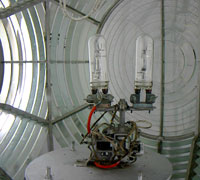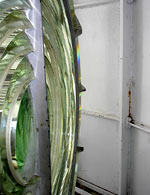![]()
Lighthouse keepers have kept our lights of the coast aglow through a variety
of ways over the years. In time, the great bonfires were replaced by devices
that burned many different fuels such as lard, oil derived from sperm whales,
mineral oil, and kerosene. Prior to the invention of the Fresnel (pronunciation:
frA-'nell) lens, the effectiveness of a lighthouse was somewhat limited by
these more primitive light sources. One such light source was the Argand lamp,
which used a hollow, loop-shaped wick that provided more light than a solid
wick. Argand lamps were most often used in conjunction with a parabolic (bowl-shaped)
reflector to help increase the light's intensity. Multiple lamps and reflectors
were used when even greater intensity was required.

(photo above: The light source inside the 1st order
Fresnel lens in Point Arena Light Source, California)
Developed by Augustin
Fresnel of France and introduced in 1822, the Fresnel lens signaled the arrival
of the golden age of lighthouses.  Through
a sophisticated arrangement of prisms, the Fresnel lens focuses light into
a concentrated beam that, in some cases, could be seen from more than 20 miles
away. Designed in a series of seven sizes (called orders, 1st through 6th,
with a three-and-a-half order), the Fresnel lens could accommodate a variety
of lighthouse sizes and functions. A sixth-order lens was the smallest in
size and therefore had the smallest focal distance, while a first-order lens
was the largest and, in some cases, reached a height of up to 12 feet. Though
he died only five years after inventing the lens, Augustin Fresnel's contribution
to the lighthouse was, and still is, utilized to a great extent. From wood
fires and candles to oil lamps and incandescent bulbs, no technological advance
contributed more significantly to lighthouses than the Fresnel lens.
Through
a sophisticated arrangement of prisms, the Fresnel lens focuses light into
a concentrated beam that, in some cases, could be seen from more than 20 miles
away. Designed in a series of seven sizes (called orders, 1st through 6th,
with a three-and-a-half order), the Fresnel lens could accommodate a variety
of lighthouse sizes and functions. A sixth-order lens was the smallest in
size and therefore had the smallest focal distance, while a first-order lens
was the largest and, in some cases, reached a height of up to 12 feet. Though
he died only five years after inventing the lens, Augustin Fresnel's contribution
to the lighthouse was, and still is, utilized to a great extent. From wood
fires and candles to oil lamps and incandescent bulbs, no technological advance
contributed more significantly to lighthouses than the Fresnel lens.
 Point
Arena California
Point
Arena California